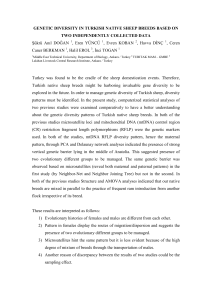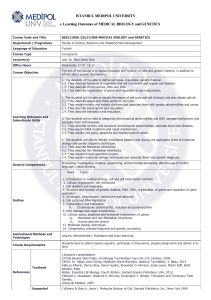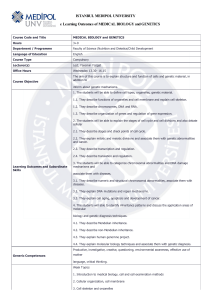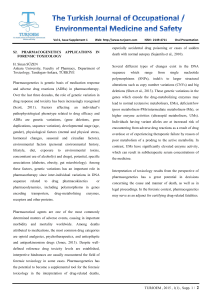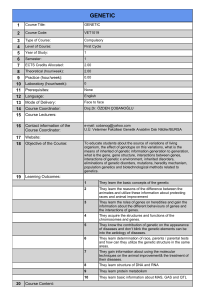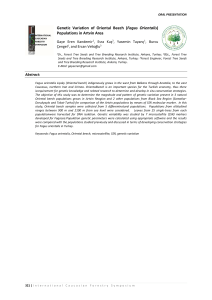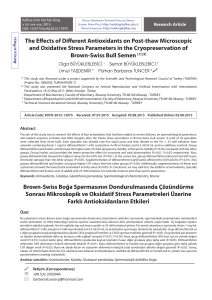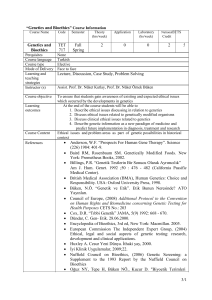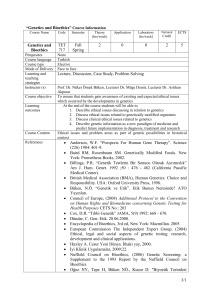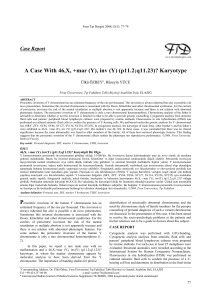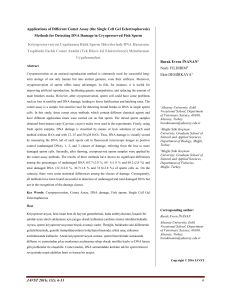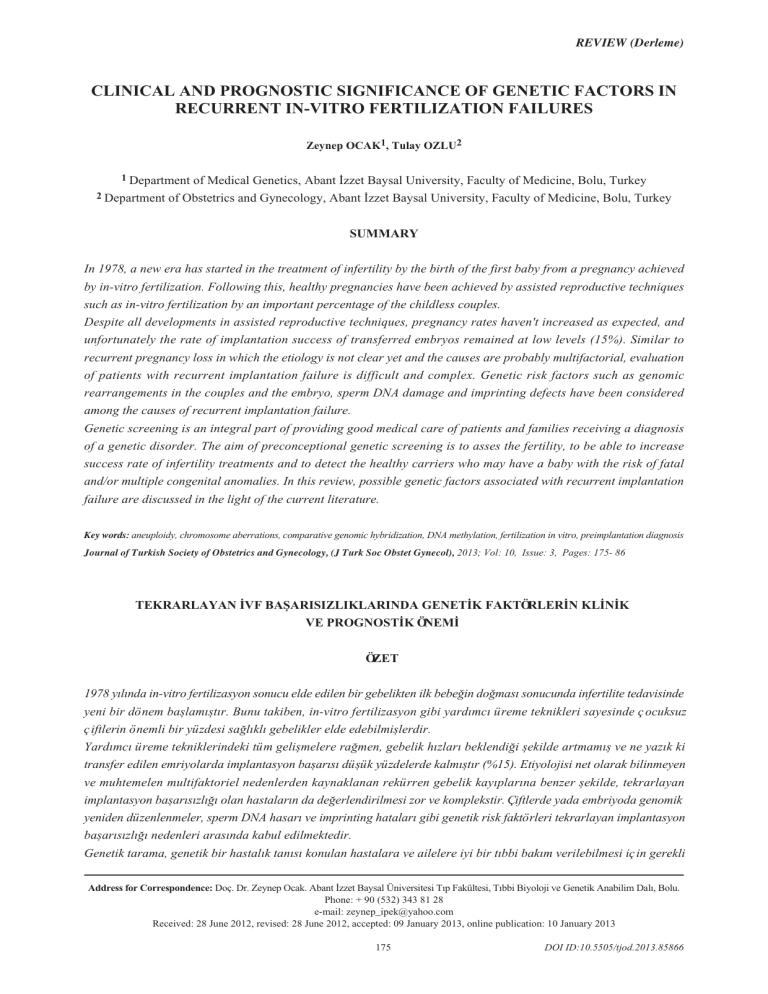
REVIEW (Derleme)
CLINICAL AND PROGNOSTIC SIGNIFICANCE OF GENETIC FACTORS IN
RECURRENT IN-VITRO FERTILIZATION FAILURES
Zeynep OCAK1, Tulay OZLU2
1 Department
2 Department
of Medical Genetics, Abant ‹zzet Baysal University, Faculty of Medicine, Bolu, Turkey
of Obstetrics and Gynecology, Abant ‹zzet Baysal University, Faculty of Medicine, Bolu, Turkey
SUMMARY
In 1978, a new era has started in the treatment of infertility by the birth of the first baby from a pregnancy achieved
by in-vitro fertilization. Following this, healthy pregnancies have been achieved by assisted reproductive techniques
such as in-vitro fertilization by an important percentage of the childless couples.
Despite all developments in assisted reproductive techniques, pregnancy rates haven't increased as expected, and
unfortunately the rate of implantation success of transferred embryos remained at low levels (15%). Similar to
recurrent pregnancy loss in which the etiology is not clear yet and the causes are probably multifactorial, evaluation
of patients with recurrent implantation failure is difficult and complex. Genetic risk factors such as genomic
rearrangements in the couples and the embryo, sperm DNA damage and imprinting defects have been considered
among the causes of recurrent implantation failure.
Genetic screening is an integral part of providing good medical care of patients and families receiving a diagnosis
of a genetic disorder. The aim of preconceptional genetic screening is to asses the fertility, to be able to increase
success rate of infertility treatments and to detect the healthy carriers who may have a baby with the risk of fatal
and/or multiple congenital anomalies. In this review, possible genetic factors associated with recurrent implantation
failure are discussed in the light of the current literature.
Key words: aneuploidy, chromosome aberrations, comparative genomic hybridization, DNA methylation, fertilization in vitro, preimplantation diagnosis
Journal of Turkish Society of Obstetrics and Gynecology, (J Turk Soc Obstet Gynecol), 2013; Vol: 10, Issue: 3, Pages: 175- 86
TEKRARLAYAN ‹VF BAfiARISIZLIKLARINDA GENET‹K FAKTÖRLER‹N KL‹N‹K
VE PROGNOST‹K ÖNEM‹
ÖZET
1978 y›l›nda in-vitro fertilizasyon sonucu elde edilen bir gebelikten ilk bebe¤in do¤mas› sonucunda infertilite tedavisinde
yeni bir dönem bafllam›flt›r. Bunu takiben, in-vitro fertilizasyon gibi yard›mc› üreme teknikleri sayesinde çocuksuz
çiftlerin önemli bir yüzdesi sa¤l›kl› gebelikler elde edebilmifllerdir.
Yard›mc› üreme tekniklerindeki tüm geliflmelere ra¤men, gebelik h›zlar› beklendi¤i flekilde artmam›fl ve ne yaz›k ki
transfer edilen emriyolarda implantasyon baflar›s› düflük yüzdelerde kalm›flt›r (%15). Etiyolojisi net olarak bilinmeyen
ve muhtemelen multifaktoriel nedenlerden kaynaklanan rekürren gebelik kay›plar›na benzer flekilde, tekrarlayan
implantasyon baflar›s›zl›¤› olan hastalar›n da de¤erlendirilmesi zor ve komplekstir. Çiftlerde yada embriyoda genomik
yeniden düzenlenmeler, sperm DNA hasar› ve imprinting hatalar› gibi genetik risk faktörleri tekrarlayan implantasyon
baflar›s›zl›¤› nedenleri aras›nda kabul edilmektedir.
Genetik tarama, genetik bir hastal›k tan›s› konulan hastalara ve ailelere iyi bir t›bbi bak›m verilebilmesi için gerekli
Address for Correspondence: Doç. Dr. Zeynep Ocak. Abant ‹zzet Baysal Üniversitesi T›p Fakültesi, T›bbi Biyoloji ve Genetik Anabilim Dal›, Bolu.
Phone: + 90 (532) 343 81 28
e-mail: [email protected]
Received: 28 June 2012, revised: 28 June 2012, accepted: 09 January 2013, online publication: 10 January 2013
175
DOI ID:10.5505/tjod.2013.85866
Zeynep Ocak and Tulay Ozlu
bir uygulamad›r. Prekonsepsiyonel genetik taraman›n amac› fertiliteyi de¤erlendirmek, infertilite tedavilerinin
baflar›lar›n› art›rabilmek, ve fatal ve/veya çoklu konjenital anomaliler ile etkilenmifl çocuk do¤urabilecek sa¤l›kl›
tafl›y›c›lar› tespit edebilmektir. Bu derlemede, tekrarlayan implantasyon baflar›s›zl›¤› ile iliflkili muhtemel genetik
faktörler güncel literatür bilgileri ›fl›¤›nda tart›fl›lm›flt›r.
Anahtar kelimeler: anöploidi, DNA metilasyonu, karfl›laflt›rmal› genom hibridizasyonu, kromozom aberasyonlar›, preimplantasyon tan›, tüp bebek,
Türk Jinekoloji ve Obstetrik Derne¤i Dergisi, (J Turk Soc Obstet Gynecol), 2013; Cilt: 10, Say›: 3, Sayfa: 175- 86
2,90%
10,00%
5,90%
15,00%
43
44
5,00%
0,00%
0-35
35-37
38-40
41-42
Figure 1: The relationship between IVF success and live birth rate
depending on the age
Immunological and
suboptimal culture conditions
zygote
The number and quality
of embryos
embryo
Genetic abnormalities
Low embryo quality
Types of anauploidy
Poor development of the embryo
Figure 2: The main factors affecting the success of implantation.
J Turk Soc Obstet Gynecol 2013; 10: 175- 86
18%
20,00%
RIF is a complex procedure in which factors belonging
to the mother, the father and the embryo play a role.
The low quality of oocytes and embryo and
chromosomal aneuploidy due to the advanced age of
the mother are among the main factors.
Age
Genetic abnormalities
Environmental and immunology conditions
14.50%
25,00%
ETHIOLOGY OF RECURRENT
IVF FAILURE
Oosit
sperm
27%
30,00%
Age
Genetic abnormalities Suboptimal
ovaryan stimulation Immunological
conditions
IVF success rate
25.40%
35,00%
36%
40,00%
Live birth rate
35,10%
45,00%
43%
Repetitive in-vitro fertilization failure (RIF) is defined
as the absence of pregnancy although a good quality
embryo has been transferred following at least three
successive in-vitro fertilization (IVF)/Intracytoplasmic
Sperm Injection (ICSI)-Embryo Transfer (ET)
procedures(1,2). In spite of the evolution of the assisted
reproduction techniques, the rate of implantation success
is around 15 %(3,4). The etiology of this situation has
not been explained yet and there are probably many
reasons for that. That is why the evaluation of the RIF
patients is especially difficult and complex.
The analysis of genetic factors in IVF applications is
really important for the success of the procedure and
for the determination of couple-specific procedural
way. The genetic screening planned for these patients
should be made during pre-conception period or during
the evaluation of the fertility state.
41,10%
The IVF success and live born rates decrease with the
age of the mother as shown in previous studies
(Figure1). Again in mothers, anatomic changes such
as endometrial polyps and submucous fibroids, the
presence of antithyroid antibodies and antinuclear
antibodies that can lead to the development of immune
reaction against the embryo may be the cause of RIF
or recurrent pregnancy loss (RPL). The presence of
genetic abnormalities such as chromosomal anomalies,
single gene diseases, multi-factorial diseases and sperm
aneuploidies(5,6), suboptimal ovarian stimulation
protocols, suboptimal culture conditions, unsuitable
embryo transfer technique and embryo-based conditions
may affect the success of the implantation(7,8)(Figure
2).
DEFINITION AND IMPORTANCE
176
Transfer
Suboptimal embryo transfer
technique
Clinical and prognostic significance of genetic factors in recurrent in-vitro fertilization failures
1) Genetic factors acting in recurrent IVF failure
a. Chromosomal anomalies:
Previous studies reported that, more than 80% of the
pregnancy losses occur in the first trimester and the
analysis of the fetus or the abortion material has shown
presence of chromosomal anomalies in 53% of the
cases(9). In the same way, high level of chromosomal
anomalies has been detected in the embryo of RIF
couples using pre-implantation genetic screening (PGS).
Among these, the most frequently observed chromosomal
anomalies are aneuploidies. In addition, numerous and
complex anomalies involving 3 or more chromosomes
have also been reported(9,10). The detection of aneuploid
fetus with the analysis of RPL mothers' abortion material
in many studies have shown that this risk is higher in
mother with advanced age (5). Independently from the
age of the mother, low rates of X chromosome mosaicism
detected to have mosaic X chromosome monosomy, the
couples applying for IVF needs to be submitted to PGS
and prenatal diagnosis.
In sperm FISH studies performed on men with normal
karyotype and abnormal spermiogram, an increase in
numerical chromosome abnormalities and diploid
sperm ratio was observed and these observations were
reported to be associated with sperm number and
motility(12). In sperm aneuploidy studies, anomalies
of sex chromosomes and chromosome number 21 and
22 are were frequently observed(13). In studies on nonmosaic XXY-Klinefelter cases, sex chromosome
disomy rate was 7.69%; this rate was 2.54% in mosaic
(XY/XXY) cases and 3.97% in XYY cases(14-16). Thus,
when an IVF is planned due to male factor, sperm
aneuploidy should be investigated with sperm FISH
studies and the family should be offered PGS and
observed in FISH analysis performed on RPL mothers'
blood and buccal smear using X-alpha satellite probes
are also considered as an important risk factor for
RPL(11). Thus, if a mother is at an advanced age or is
prenatal diagnosis (Figure 3).
In couples with RPL, the frequency of being a carrier
for a structural chromosomal anomaly of at least one
of the parents varies between 3 and 11%(17). Among
Normal karyotype
Karyotype
Structural
chromosomal
abnormalities
Subtelomeric
rearrangement?
Subtelomeric
FISH
or a CGH
Sperm FISH
(diploid or
aneuploidy sperm?)
Genetic counselling
PGD
Prenatal diagnosis
Sperm donation
Sperm DNA
Demage
(DFI rate?)
IMSI
Genetic counselling
PGD
Prenatal diagnosis
Sperm donation
Inversion
Rob. translocation
Resp. translocation
(Sperm FISH)
(Abnormal sperm
rate?)
Genetic counselling
PGD
Prenatal diagnosis
Sperm donation
(-)
Genetic
counselling
(+)
Mosaic?
Sperm FISH
(disonyhiperhoploidi?
Sperm FISH (45,X)
46 XY mosaic?
Genetic
counselling
Sex chromosomal
abnormalities
Male factor
Y chromosome
deletion
Genetic
counselling
(Azfe deletion+)
Congenital bilateral
absence of teh vas
deferens,
Kallman etc.
single
gene disease
Mutation
analysis+
Imprinting
defect?
Genetic
counselling
PGD
Prenatal
diagnosis
Immunological
factors?
HLA
typing?
Do you have similar
Class I and
Classe II?
Partner +
mutation
(+)
Genetic counselling
PGD
Prenatal diagnosis
Genetic counselling
PGD
Prenatal diagnosis
+
Genetic counselling
PGD
Prenatal diagnosis
-
Genetic
counselling
Genetic
counselling
Figure 3: The Genetic Approch to Planned IVF Application for Male Factors.
177
J Turk Soc Obstet Gynecol 2013; 10: 175- 86
Zeynep Ocak and Tulay Ozlu
these structural abnormalities, the most frequently
observed anomaly is autosomal chromosomal
translocations. The frequency of chromosomal
translocations is 2.5% in RIF couples, 9.2% in RPL
couples and 0.2% in newborns(9,11). It has been declared
that in couples carrying chromosomal anomalies, IVF
and pregnancy success rate may decrease and there
may be an increased risk of abortion(10). These couples
may also have a fetus with a chromosome anomaly
that may lead to congenital anomalies, mental
retardation and short life-span(17).
The abnormal sperm ratio varies between 3.4 and 40%
in men carrying a Robertsonian translocation and
between 47.5 and 81% in those carrying a reciprocal
translocation(18). The patients who are translocation
carriers may produce more abnormal embrios than
expected in association with abnormal sperm
in RPL couples are pericentric inversions. In men
carrying inversions, abnormal spermatocyte frequency
varies between 0 and 54.3% according to the length
of the inversion and formation of a stich or not by the
chromosome(19,20).
Since the rearrangements of the chromosomes affecting
the telomeric regions can also produce abnormal
gametes, it is reported that these rearrangements may
also lead to RIF and RPL. Because of all these reasons,
it is recommended to perform pre-implantation genetic
diagnosis (PGD) when a structural anomaly is detected
in at least one of the patients(21). (Figure 3,4). Use of
more sensitive methods such as subtelomeric FISH or
Array-Comparative Genomic Hybridization (a-CGH)
for anomalies that cannot be detected by conventional
cytogenetic examinations(21,1).
In the recent years, the effect of polymorphisms of
production. Inversions are an other type of structural
chromosomal changes(19,20). They are important since
the carrier individuals may develop abnormal gametes.
5-10% of the major chromosomal anomalies detected
heterochromatin region of the chromosomes on
reproductive health has been investigated. Even if they
do not lead to known genetic diseases, it is thought
that these polymorphic changes may be responsible
Normal
karyotype
Subtelomeric
rearrangement?
Subtelomeric
FISH or
a CGH
(+)
Genetic ounselling
Prenatal
diagnosis
Structural
chromosomal
abnormalities?
Inversion
Rob. translocation
Resp. translocation
Sex
chromosomal
abnormalities
Turner stigma?
Gonadal dysgenesis?
Mosaic?
Single gene disorders?
Multifactorial
disease?
Genetic
counselling
Mutation analysis
Genetic
counselling
Congenital or
acquried
thrombophilia?
Homosistein
levels?
Genetic
counselling
Subclinical infections?
History of chronic
endometritis?
Urea-urethral swab
Chlamydia trachomatis,
Ureaplasma, Mycoplasma
DNA?
‹nfection
control
Autoimmune
disorders?
Immunological
factors?
SLE?
APS?
HLA typing?
Do you have similar
Class I and
Class II?
Genetic
counselling
Mitochondrial
disease?
mtDNA mutation?
mt DNA deletion?
(+)
Heterplasmi?
Karyotype
Female factor
Figure 4: The Genetic Approch to Planned IVF Application for Female Factors.
J Turk Soc Obstet Gynecol 2013; 10: 175- 86
178
Genetic
counselling
PGD
Genetik dan›flma
Genetic
counselling
Genetic counselling
PGD
Prenatal diagnosis
Clinical and prognostic significance of genetic factors in recurrent in-vitro fertilization failures
from reproductive failure and be the cause of RPL
(17). Increased aneuploidy rates detected by sperm
FISH has been reported in male patients with
heterochromatin polymorphism(17,22,23).
The mode of action of heterochromatin changes on
mechanisms of sperm production are not known yet,
however, with the detailed analysis of the changes that
are suspected to be normal variants, how these interact
with the genes acting in sperm production will be
clarified.
c. Sperm DNA Damage:
Tests including sperm number, morphology and motility
that indirectly evaluate male infertility are widely used
in fertility clinics. In last years, the detection of high
sperm DNA damage in patients with abnormal semen
parameters brought up new approaches(25). Sperm
DNA damage may develop with different mechanisms
such as abnormal chromatin packing, reactive oxygen
species (ROS) and sperm apoptosis(26). The potential
effect of sperm DNA integrity on male infertility is
unknown. Damaged sperm that cannot be repaired
enter the apoptosis process and lose their fertile capacity
(27). DNA damage occurring in male germ cells with
increasing age of the father are repaired by DNA repair
mechanisms under normal conditions and
reproduction/fertilization pursue(28). However, as sperm
DNA damages have been detected in 8% of the patients
b. Y Chromosome Microdeletion:
Lower fertilization and pregnancy rates have been
reported in cases with Y chromosome deletion. Y
microdeletion is mostly de novo in patients(24). The
deletions are mostly localized on the long arm of Y
chromosome (Yq11). The locus of deletion on Y
chromosome is important for its effect on
spermatogenesis. Y chromosome microdeletion is
observed at a rate of 10-15% in patients with azospermia
or severe oligozoospermia(20,24). AZFc deletion has
been detected in 16% of azospermia patients and in
5% of oligozoospermia patients. The frequency of
AZFc deletion in the population is supposed to be
1/4000(20). AZFb deletions are observed in 2% of the
patients(18,21).
In couples who are fertile but who present RPL, Y
chromosome deletions may have an etiological role. In
a study about the interaction of RPL and proximal AZFc
deletion, 14(82%) the of 17 patients with RPL were
found to have a deletion in proximal AZFc region of
the Y chromosome, while no deletion has been observed
in patients having live birth(20,23,24).
In addition to that, 45,X/46,XY mosaicism may be
detected in the gonads of the father with an AZFc
deletion as a result of loss of Y chromosome. This
way, monosomic embryo for X may be produced by
ICSI or 45,X/46,XY mosaicism may occur due to
unstable Y chromosome transferred to the male embryo
at early stages. Because of this mosaicism, birth of a
male baby with ambiguous external genitalia or mixed
gonadal disgenesis has been reported(24). It has been
recommended to perform Y chromosome microdeletion
test in addition to karyotype analysis to IVF candidates
depending on the indication before IVF/ICSI
procedures.
with normal semen parameters, their effect on IVF and
ICSI results are still discussed.
It has been demonstrated that the oocyte may
compensate sperm DNA fragmentation in cases with
a DNA fragmentation index (DFI) up to 30% which
is measured using Sperm Chromatin Structure Analysis
(SCSA) and shows the level of DNA denaturation(29).
In fertile couples with a DFI<30%, the possibility to
get pregnant by ICSI and IVF is reported to be 2 times
higher (30) . However, in patients with DNA
fragmentation >30%, even if the first 3-days of embryo
development will not be affected, healthy blastocyte
development and pregnancy will not follow(31,32). In
a study of Bungum et al. including 387 intrauterine
insemination (IUI) cycles with DFI >%30, which is
the largest series up to date, biochemical pregnancy,
clinical pregnancy and birth rate have been found to
be significantly low in patients(28). However, in studies
about this topic, the correlation detected between DFI
and sperm aneuploidy is contradictory. In two studies
about the relation between DFI and sperm aneuploidy,
a positive relation has been observed, while this has
not been observed in a different study performed in
the recent years. In these three studies, embryo
aneuploidies have not been evaluated(33). In another
prospective randomized study of Balaban et al.,
implantation and clinical pregnancy rates of
intracytoplasmic injection of morphologically selected
sperm (IMSI) cases was compared with that of ICSI
cases. As a result, the rates of 19.5% and 54.0%
observed in ICSI have respectively increased to 28.9%
179
J Turk Soc Obstet Gynecol 2013; 10: 175- 86
Zeynep Ocak and Tulay Ozlu
and 54.0% with IMSI(34). Thus, routine IMSI have
been recommended for couples with five or more
RIF(34).
Problems such as production of embryo with high
aneuploidy rate, early pregnancy losses, risk of
metabolic diseases associated with epigenetic
modifications, childhood cancers are still subjects of
investigations. The relation between damaged sperm
DNA used in ICSI and the potential effects on the child
is not clear, further studies are required. Further larger
studies are required to detect the mechanisms of
occurrence of sperm DNA damage and their effects
on IVF success.
(36). These situations that can directly lead to fetal death
should be analyzed before IVF applications.
e. Polymorphic Modifications:
According to the data obtained from studies, mutations
and polymorphisms in some genes such as p53, HLAG, VEGF and IL-1RN play a genetic role for RIF after
IVF. Sipak-Szmigiel et al. have studied the existence
of a relation between gene polymorphism of HLA-G
antigen expressed in trophoblast cells of the fetus and
RIF. This antigen which plays an important role in
pregnancy physiology participates to the formation of
maternal immune system during pregnancy. As the
antigen may also be detected in some blastocysts, it
may have a role in implantation. Previous studies have
shown that HLA-G gene polymorphism may lead to
preclampsia, RPL and RIF(37). In the study of Sipak-
d. Single Gene Disease and Multifactorial Diseases:
Single gene diseases may lead to RPL and IVF failures
especially in patients with family history. These diseases
are supposed to affect pregnancy losses in two ways.
The first one is the development of a disease in the
fetus that can be incompatible with life, while the other
one is the possibility that single gene disease present
in mother adversely affects the pregnancy. Single gene
diseases such as sickle cell anemia, alpha thalassemia,
Zelweger disease and glutaric aciduria for which the
incidence increases in consanguineous marriage may
lead to pregnancy losses(23). According to the data of
PGD Consortium of 2012 of the European Society of
Reproduction and Embryology (ESHRE), 4733 cycles
have been performed for single gene diseases in the
last ten years. According to this report, PGD have been
mostly performed for cystic fibrosis, sickle cell anemia
and spinal muscular dystrophies. For autosomal
dominant diseases, PGD has been mostly used for
myotonic dystrophy(36).
Hereditary recessive defects of X chromosome may
be lethal for the male fetus in intrauterine environment.
In a study about the X-linked lethal genes in women
with RPL, a higher amount of shifted X inactivation
pattern compared to the control group has been observed
(22,23). X chromosome inactivation in a certain region
in more than 90% of the cells has been highlighted.
Same results have been obtained in leucocytes, oral
mucosa cells and muscle biopsies. The locus with
genetic defects has been mapped on Xq28 region
(23).
Nowadays, PGD is mostly performed for Fragile X
syndrome, Duchenne muscular dystrophy (DMD) and
hemophilia among X chromosome-associated diseases
J Turk Soc Obstet Gynecol 2013; 10: 175- 86
Szmigiel et al., a relation between HLA-G gene
polymorphism and increased RIF risk has been
established(37). Goodman et al. have shown in a study
that -1154A/A polymorphism of VEGF gene which is
the best characterized regulator of angiogenesis may
be a factor of RIF(38). In a study of Goodman et al.,
the Pro 72 polymorphism of the p53 gene that is
supposed to act in fertility and to regulate reproduction,
the 4G/4G polymorphism of the PAI gene which
encodes proteins that have a role in coagulation and
1154A/A polymorphism of the VEGF gene were
reported to have a relation with RIF(39).
Using all these data, it has been proposed that
polymorphisms may play a role in RIF development
and that it will be useful to prepare a test panel to
determine these gene polymorphisms to detect women
who will be under risk of RIF after IVF.
f. Mitochondrial Modifications:
Rearrangements, long region deletions and point
mutations in mtDNA genome are important for sperm
motility and morphology. It has been demonstrated
that genetic modifications in sperm mtDNA affect
sperm function and thus the normal fertilization(40).
An increase is observed in abnormal sperm and sperm
mtDNA in infertile men and this increase creates
serious problems during ICSI. The total loss of
mitochondrial rRNA or tRNA may lead to the arrest
of mitochondrial protein synthesis and affect early
embryonic development and thus may provoke fetal
death(55,56). Also, an increase of defective mtDNA in
180
Clinical and prognostic significance of genetic factors in recurrent in-vitro fertilization failures
ovarian dysfunction that occurs with advanced age of
the mother has been described in literature(40).
antigen in women, they may have similar human
leukocyte antigens (HLA). As this similarity has been
proposed as a cause of RPL and RIF, analysis of class
I and class II HLA of the couples and treatment with
high dose IV immunoglobulin has been recommended
in the literature(46).
It has been declared that hereditary and acquired
thrombophilias create local micro thrombi in maternal
vascular structure on the implantation surface and
affect the microcirculation, thus leading to RIF and
early pregnancy losses(47). Antiphospholipid antibody
syndrome (AFS) which is one of the causes of acquired
thrombophilias, is an autoimmune pathology leading
to fetal death and RPL due to arterial and venous
thrombosis. Antiphospholipid antibodies are observed
in 14% of the total population and in 30-50% of patients
with systemic lupus eritamatosis (SLE). Besides,
g. Methylation-Imprinting Defects:
The methylation of germ cell genome is important both
for normal spermatogenesis and embryo development
following fertilization. The major epigenetic regulator
for the cellular genome to be able to function is reported
to be DNA methylation. It has been observed that genome
imprinting defects lead to hypospermatogenesis and that
oligozoospermic men transfer this imprinting defects to
their children(41).
Due to the methylation of sperm and oocyte during
fertilization, transcription is not possible. But chromatin
DNA reorganizes by making modifications in
methylation state to permit the somatic development of
the embryo after it becomes diploid. In that purpose,
the genome obtained from the father undergoes
demethylation within few hours after fertilization while
the genome obtained from the mother undergoes a
passive demethylation process following the two-cell
embryo period. After the development of morula and
blastocyst, the two genomes have undergone equal
demethylation and then new methylation occurs(42).
Benchaib et al. have shown in a study that methylation
defects may lead to abnormal fetal development, diseases
such as Angelman syndrome and Beckwith-Wiedemann
syndrome and that pregnancy success increases with
the increase of methylation(42,43).
temporary antiphospholipid antibodies may be detected
in Syphilis, Lyme disease, in frequent viral and
mycoplasma infections as well as with the use of drugs
such as chlorpromazine, clonidine, phenytoin,
procainamide. But in these situations, thrombosis does
not develop(48).
Studies have shown that, almost all of the fetal deaths
observed in women with SLE were associated with
AFS (lupus anticoagulant-LA and anticardiolipin
antibodies-ACA)(47,48). These antibodies are the most
sensitive indicators in fetal distress and death. Besides
the clinical criteria, demonstration of medium or high
levels of ACA (IgG or IgM) constitute an important
laboratory diagnostic criteria. In spite of this relation
between AFS and RPL, American Society of
Reproductive Medicine (ASRM) has reported in 2008
that AFS does not affect IVF success(49). In this report,
16 review articles and 2053 cases have been investigated
bot individually and globally and no statistically
significant difference has been observed between AFS
and IVF success(49).
In literature, there are at least 694 studies about the
effect of hereditary thrombophilic gene mutations on
RPL and IVF success(50). Among these, when review
articles, meta analyses and case presentations are
considered, it has been observed that at least 6092
cases have been studied. Case control studies showed
that, when more than one AFS antibody have been
detected, the risk of IVF failure is three times the
normal value(50).
h) Immunologic Factors and thrombophilias
Nowadays, effects of abnormalities in local immune
functions at the maternal and fetal surfaces on
implantation success are an emerging issue(44). In last
years, studies in immunology have shown that 80% of
the unexplained abortions may be associated with
immunologic factors. Alloimmune defects, cytotoxic
antibodies, "natural killer" cells function and dispersion
anomalies constituting an abnormal maternal immune
response against fetal and placental antigens are among
immunologic factors that can affect IVF success(44).
Most of these may be prevented using new treatment
methods(7). If all the tests performed on the couples
before IVF are normal, immunologic factors that may
affect the implantation should be taken into
consideration. For this, the first thing to do is to observe
immunologic reactions with a lymphocyte cross-match
test of the couples. If there is no reaction against male
181
J Turk Soc Obstet Gynecol 2013; 10: 175- 86
Zeynep Ocak and Tulay Ozlu
Cohort studies showed no relation between AFS and
live births and pregnancy rate(50). In eight case control
studies, the success of IVF decreased three times
compared to normal conditions in patients with Factor
V Leiden mutation(50). This relation has not been
established in two cohort studies. The homozygote
mutation of methylene tetrahydropholate reductase
(MTHFR) gene was demonstrated to cause
hyperhomocystinemia leading to defects in chorion
villous vascularization, increasing the risk of early
pregnancy loss(51,52). This mutation also increases the
NTD risk in the fetus up to 1.9 times(51). In spite of all
fetal effects of MTHFR mutation that can affect folate
metabolism, its relation with RIF has not been proved.
In a recent study of Laanpere et al., it has been proposed
that a heterozygote modification of gene working in
folate metabolism causes a decrease in ovarian
supported the potential role of genital canal infections
on IVF-ET failure in a review article(58).
With these information, even if screening for these
infections before IVF seems to be useful in a patient
who does not have clinic infection findings or is not
under risk of sexually transmitted diseases, there are
not enough studies proving the necessity to perform it
in routine practice. On the other side, routine screening
for HIV, hepatitis B, hepatitis C infections should be
performed before IVF procedure. This is important for
the protection of the fetus obtained by IVF as well as
members of the the clinical and laboratory team and
to prevent cross contamination between frozen embryos.
stimulation and IVF success compared to the control
group(50).
Even if there are many people thinking that thrombophilia
in fetus may increase the risk of pregnancy loss, there
is no clear proof about this issue yet(53). There are few
cases of pregnancy loss, early birth and cerebral palsy
defined in literature(54).
Multiple thrombophilic gene mutation rate is 74% in
women with RPL and 20% in control group(52). Based
on these data, it is possible to declare that thrombophilia
screening will be useful in RIF patients before IVF/ICSI
procedures (Figure 4).
FAILURES
PREIMPLANTATION GENETIC DIAGNOSIS
AND ARRAY CGH APPLICATION IN IVF
In a report published by ESHRE PGD Consortium, more
than 27 000 cycles from 39 different centers have been
performed; of these, 61% were for aneuploidy, 17% were
for single gene diseases, 16% were for chromosomal
anomalies, 4% were for X-associated diseases and 2%
were for social indications(36).
PGS is a technique used to chose and transfer the best
embryo obtained by IVF by evaluating aneuploidies
of the embryo. One of the main reasons to use PGS is
to increase implantation success in IVF centers or to
decrease pregnancy losses(36). PGS technique should
especially be used for patients with advanced maternal
age or couples with RPL or RIF.
In previous studies, pregnancy rate per oocyte increased
from 29% to 38% and the abortion rate in carrier parents
decreased from 92% to 12.5% after PGS application(59).
FISH technique has been frequently used for aneuploidy
and translocation screening. With the FISH technique,
the analysis of limited number of chromosome, the
debatable results, the use of unsuitable biopsy and
fixation techniques lead to different results(60). As an
alternative to FISH technique, aCGH technique permits
the analysis of all chromosomes in the embryo. This
technique may be used indications such as advanced
maternal age, RPL, RIF, severe male factor and
translocation and inversion carriers. 30-40% of
chromosome deficiencies determined by aCGH cannot
be determined by FISH technique(60,61).
Different from PGS, PGD is based on a selective
2) Subclinical Infections:
Chlamydia trachomatis, Ureoplasma and Mycoplasma,
Toxoplasma gondii, Listeria Monocytogenes, Herpes
virus and Cytomegalovirus infections may cause
RPL(55). However, the data about cervicovaginal
infections as a cause of early pregnancy losses are
insufficient and contradictory(56).
Kamiyama et al. have evaluated the existence of a
relation between subclinical upper genital tract infections
and IVF-ET failure; no pregnancy has been observed
in 38 patients with menstrual blood endotoxin
concentration higher than a threshold value while
pregnancy has been detected in 1/3 of the patients with
an endotoxin concentration within accepted limits(57).
They proposed that early colonization of the endometrium
by Gram negative bacteria affects the implantation or
triggers early spontaneous loss thus causing IVF-ET
failure. Based on these results, Romero et al. also
J Turk Soc Obstet Gynecol 2013; 10: 175- 86
182
Clinical and prognostic significance of genetic factors in recurrent in-vitro fertilization failures
bioinformatic studies(61).Bacause of the expectations
and unanswered questions, array-SNP applications lead
to anxiety, but they also cause some concerns because
of the present problems in healthy evaluation of some
data and the ethical dilemma. Even if all these studies
performed at pre-implantation stage give rapid results,
they are still laborious and difficult.
The accreditation of PGD laboratories with ISO 15189
or its equivalent and the data sharing by PGD
researchers in scientific meeting will play an important
role. The organization of an educational programs for
the association of cytogenetic and molecular genetics
disciplines will help develop this technique (63).
transfer of embryo in couples carrying genetic diseases
such as structural chromosomal rearrangements like
translocations, familial genetic diseases or carriers of
genetic diseases. By this way, it is aimed to increase
the chance of the couples for having a healthy children
and to decrease the amount of pregnancy terminations
due to medical indications.
Due to frequent consanguineous marriages in our country,
it is important to perform PGD in autosomal recessive
diseases such as beta-thalassemia. PGD applications are
now developed for autosomal dominant diseases such
as myotonic dystrophy, Huntington disease, and Marfan
syndrome. PGD application frequency for autosomal
dominant diseases is reported to be lower compared to
that for autosomal recessive diseases(36). However, we
suppose that PGD applications will increase in the near
future since the risk of passage of the autosomal dominant
diseases to the embryo is higher than recessive
diseases(36).
Even if PGD procedure seems to be advantageous for
IVF applications, it also leads to problematic situations.
The procedure is very expensive especially in countries
such as England where prenatal diagnosis is endorsed
by the government but the PGD is not. The most
difficult part of PGD for fertile couples is the necessity
to undergo IVF. Also, the possibility to have false
positive or negative results is one of the disadvantages
which should also be mentioned during genetic
counseling. The other disadvantage of the PGD is the
ethic apprehension it brings. Use of PGD application
in hereditary cancers without a penetrance of 100%,
in late onset genetic diseases such as Huntington disease
and in situations like non-fatal hearing loss may lead
to ethical apprehension(36,62).
Single nucleotide polymorphism-copy number variation
(SNP-CNV) technique that permits the detection of
structural chromosomal abnormalities such as
microdeletions, duplications uniparental disomies and
marker chromosomes besides the numerical chromosome
abnormalities, has also gained popularity in the last
years. In this technique based on oligo aCGH,
approximately 250.000 genomic data may be analyzed
at once. Following whole genome amplification on one
blastomer, 250.000 SNP regions may be analyzed (61).
Even if the recent data show that implantation and
pregnancy success increased following microarray tests,
the results may not be evaluated correctly and should
be supported with long-term and comprehensive
GENETIC EVALUATION
As a result; the utilization of genetic diagnosis before,
during and after the application of assisted reproductive
techniques is a part of good clinic practice. These tests
will permit right diagnosis and suitable genetic
counseling. During the process of decision about the
tests to perform, the evaluation of family history in
addition to clinic findings will be more beneficial for
the patient.
In genetic screening for reproductive health, the aim
should be the detection of healthy carriers who may
give birth to a baby with fatal and/or severe anomalies.
The cost and the efficiency of the test for the detection
of the etiological cause should be taken into
consideration while deciding which test will be
performed on RIF couples. Tests performed for genetic
screening should be able to provide correct information
about their reproductive health to individuals or couples
with a disease to facilitate their decision making process.
REFERENCES
1.
Ly KD, Aziz N, Safi J and Agarwal A. Evidence-Based
Management of Infertile Couples with Repeated Implantation
Failure Following IVF. Current Women's Health Reviews
2010; 6: 200- 18.
2.
Macklin VM. Ovarian Stimulation and ovulation induction.
Fertil Steril 2001; 75: 88- 91.
3.
ASRM/SART Registry. Assisted reproductive technology in
the United States: Results generated from the American Society
for Reproductive Medicine/Society for Assisted Reproductive
183
J Turk Soc Obstet Gynecol 2013; 10: 175- 86
Zeynep Ocak and Tulay Ozlu
4.
Technology Registry. Fertil Steril 2000; 72: 641.
frequency of low frequent X chromosome monosomy
European Society of Human Reproduction and Embryology
mosaicism: detection by interphase FISH analysis of buccal
(ESHRE). The European ‹VF-monitoring programme (EIM),
mucosa cells and lymphocytes Rinsho Byori 2000 Oct; 48(10):
for ESHRE. Assisted reproductive technology in Europe,
955- 9.
1998. Results generated from European Registers by ESHRE.
5.
17.
Hum Reprod 2001; 16: 2459.
for subtelomeric region analysis? Turkiye Klinikleri J Med
Dewald GW, Michels VV. Recurrent Miscarriages: Cytogenetic
Sci 2010; 30: 1465- 8.
Causes and Genetic Counseling of Affected Families. Clinical
6.
18.
suppression of recombination within two pericentric inversions
Chandley AC. Chromosome anomalies and Y chromosome
in humans: a new sperm-FISH technique. Am J Hum Genet
microdeletions as causal factors in male infertility. Hum
1998; 63: 218- 24.
19.
Centers for Disease Control and Prevention, American Society
20.
meiotic errors increases with decreased sperm count in severe
Human Services, Public Health Service, Atlanta, GA, 2003.
male factor infertilities. Human Reproduction 2005; 20: 1688-
2000; 72: 641.
94.
Bolarinde O, Tin-Chiu L. ‹n-vitro fertilizasyonu takiben
21.
22.
Evaluation and Counseling of Couples with Recurrent
chromosome abnormalities with special reference to trisomy.
Miscarriage: Recommendations of the National Society of
Hum Genet 1985; 70: 11- 7.
Genetic Counselors. Journal of Genetic Counseling 2005; 14:
Delhanty J, Griffin D, Handyside A. Detection of aneuploidy
3.
23.
Hoffman, Eric P. Screening test for the lethal genetic trait of
24.
Siffroi JP, Bourhis CL, Krausz C, Barbaux S, Quintana-Murci
preimplantation sex determination by fluorescent in situ
recurrent spontaneous pregnancy loss.
hybridisation, (FISH). Hum Mol Genet 2 1993; 1183- 5.
Ishikawa M, Hidaka E, Wakui K, Nakayama K, Takagi Y,
L, Kanafani S, et al. Sex chromosome mosaicism in males
Fukushima Y, Katsuyama T. Habitual abortion and high
carrying Y chromosome long arm deletions. Hum Reprod
frequency of low frequent X chromosome monosomy
2000; 15: 2559- 62.
mosaicism: detection by interphase FISH analysis of buccal
12.
25.
two markers of sperm DNA integrity, DNA denaturation and
955- 9.
DNA fragmentation, in fertile and infertile men. Fertil Steril
Bronet F, Mart›nez E, Gaytan M, Linan A, Cernuda D, Ariza
2001; 75: 674- 7.
26.
Presence of DNA strand breaks and increased sensitivity of
miscarriage or implantation failure patients. Human
DNA in situ to denaturation in abnormal human sperm cells:
Reproduction. 2012; 1- 8.
analogy to apoptosis of somatic cells. Exp Cell Res 1993;
Vidal F, Blanco J, Egozcue J. Chromosomal abnormalities in
207: 202- 5.
27.
Egozcue S, Blanco J, Vidal F, Egozcue J. Diploid sperm and
28.
Bungum M, Humaidan P, Axmon A, Spano M, Bungum L,
Jaarola M, Martin, RH, Ashley, T. Direct evidence for
Erenpreiss J. Sperm DNA integrity assessment in prediction
suppression of recombination within two pericentric inversions
of assisted reproduction technology outcome. Hum Reprod
in humans: a new sperm-FISH technique. Am J Hum Genet
2007; 22: 174- 9.
1998; 63: 218- 24.
16.
Alvarez JG. The predictive value of sperm chromatin structure
assay. Hum Reprod 2005; 28: 2365- 7.
the origin of triploidy. Hum Reprod 2002; 17: 5- 7.
15.
Gorczyca W, Traganos F, Jesionowska H, Darzynkiewicz Z.
with the sperm or embryo aneuploidy rate in recurrent
sperm. Mol Cell Endocrinol 2001; 22; 183: 51- 4.
14.
Zini A, Bielecki R, Phang D, Zenzes MT. Correlations between
mucosa cells and lymphocytes Rinsho Byori 2000; 48(10):
M. et al. Sperm DNA fragmentation index does not correlate
13.
Mercy YL, Robin L, Bennett, Devki SS, et al. Genetic
Hassold T, Chiu D. Maternal age-spesific rates of numerical
and chromosomal mosaicism in human embryos during
11.
Harper JC, Sengupta SB. Preimplantation genetic diagnosis:
state of the ART 2011. Hum Genet 2012; 131: 175- 86.
Gynecology (Türkçe Bask›) 2006; 18: 440- 5.
10.
Pang MG, Kim YJ, Lee SH, Kim CK. The high incidence of
technology success rates, U.S. Department of Health and
implantasyon baflar›s›zl›¤›. Current Opinion in Obstetrics and
9.
Dohle GR, Diemer T, Giwercman A et al. Guidelines on Male
Infertility. European Association of Urology 2010; 4: 14- 6.
for Reproductive Medicine. 2001 assisted reproductive
8.
Jaarola M, Martin RH, Ashley T. Direct evidence for
Obstetrics and Gynecology 1986; 29: 865- 83.
Reprod 1998; 13: 45- 50.
7.
Durak B, Yesil M, et al. Is recurrent abortion an indication
29.
Ishikawa M, Hidaka E, Wakui K, Nakayama K, Takagi Y,
Immunol 2002; 55: 163.
Fukushima Y, KatsuyamaT. Habitual abortion and high
J Turk Soc Obstet Gynecol 2013; 10: 175- 86
Regan L, Rai R. Thrombophilia and pregnancy loss. J Reprod
30.
184
Duran EH, Morshedi M, Taylor S, Oehninger S. Sperm DNA
Clinical and prognostic significance of genetic factors in recurrent in-vitro fertilization failures
quality predicts intrauterine insemination outcome: a
31.
42.
prospective cohort study. Hum Reprod 2002; 17: 3122- 8.
imprinting in disruptive spermatogenesis. Lancet 2004; 22:
Liu CH, Tsao HM, Cheng TC, Wu HM, Huang CC, Chen CI,
1700- 2.
Lin DP, Lee MS. DNA fragmentation, mitochondrial
43.
dysfunction and chromosomal aneuploidy in the spermatozoa
44.
Guerin JF. Quantitation by image analysis of global DNA
Muriel L, Goyanes V, Segrelles E, Gosa´lvez J, Alvarez JG,
methylation in human spermatozoa and its prognostic value
Ferna´ndez JL.Increased Aneuploidy rate in sperm with
in in vitro fertilization: a preliminary study. Fertil Steril 2003;
80: 947- 53.
dispersion (SCD) test and fish analysis. J Androl 2007; 28:
45.
pregnancy risk of antiphospholipid antibodies in association
Balasuriya A, Speyer B, Serhal P, Doshi A, Harper JC. Sperm
with systemic lupus erythematosus. J Reprod Immunol 1995;
28: 159.
fragmentation and aneuploidy in human spermatozoa. Reprod
46.
T, B, and NK cells in patients with recurrent spontaneous
Bronet F, Mart›nez E, Gaytan M, Linan A, Cernuda D, Ariza,
abortion. Altered profile and pregnancy outcome. J Immunol
1996; 156: 4027.
correlate with the sperm or embryo aneuploidy rate in recurrent
47.
miscarriage or implantation failure patients Human
48.
pregnancy risk of antiphospholipid antibodies in association
Clinical outcome of intracytoplasmic injection of spermatozoa
with systemic lupus erythematosus. J Reprod Immunol 1995;
morphologically selected under high magnification: a
28: 159.
49.
22: 472- 6.
of antiphospholipid antibodies among women experiencing
unexplained infertility and recurrent implantation failure.
quality predicts intrauterine insemination outcome: a prospective
Fertil Steril 2010; 1; 93: 2441- 3.
50.
antibodies do not affect IVF success. Practice Committee of
Moutou C, Sengupta SB, Pehlivan Budak T, Renwick P, De
the ASRM. Fertil Steril 2008; 90: S172- 3.
51.
TK, Salumets A. Folate-metabolizing gene variants and
2012; 18(3): 234- 47.
pregnancy outcome of IVF. Reprod Biomed Online. 2011;
Sipak-Szmigiel O, Cybulski C. HLA-G polymorphism and
22(6): 603- 14.
52.
Antigens 2009; 73: 348- 52.
Rey E, Kahn SR, David M and Shrier I. Thrombophilic
disorders and fetal loss: a meta-analysis. Lancet 2003; 361:
Goodman C, Jeyendran RS. Vascular endothelial growth
901- 08.
factor gene polymorphism and implantation failure. Reprod
53.
Coulam CB, Jeyendran RS. Multiple thrombophilic gene
Biomed Online 2008; 16: 720- 3.
mutations rather than specific gene mutations are risk factors
Goodman C, Jeyendran RS. P53 tumor suppressor factor,
for recurrent miscarriage. American Journal of Reproductive
plasminogen activator inhibitor, and vascular endothelial
Immunology 2006; 12: 322- 7.
growth factor gene polymorphisms and recurrent implantation
41.
Laanpere M, Altmäe S, Kaart T, Stavreus-Evers A, Nilsson
Consortium: 10 years of data collection. Hum Reprod Update
in vitro fertilization failure in a Polish population. Tissue
40.
Practice Committee of the ASRM. Anti-phospholipid
Harper JC, Wilton L, Traeger-Synodinos J, Goossens V,
Rycke M, Geraedts JP, Harton G.The ESHRE PGD
39.
Sauer R, Roussev R, Jeyendran RS, Coulam CB. Prevalence
Duran EH, Morshedi M, Taylor S, Oehninger S. Sperm DNA
cohort study. Hum Reprod 2002; 17: 3122- 8.
38.
Ogasawara M, Aoki K, Hayashi Y. A prospective study on
Balaban B, Yakin K, Alatas C, Oktem O, Isiklar A, Urman B.
prospective randomized study. Reprod Biomed Online 2011;
37.
Simon A, Laufe N. Repeated implantation failure: clinical
approach Fertility and Sterility 2012; 97, 15- 0282.
Reproduction 2012; Vol.00, No.0 pp. 1- 8.
36.
Lachapelle MH, Miron P, Hemmings R, Roy DC. Endometrial
Biomed Online 2011; 22: 428- 36.
Nogales M. at al. Sperm DNA fragmentation index does not
35.
Ogasawara M, Aoki K, Hayashi Y. A prospective study on
38- 49.
chromatin dispersion test in the assessment of DNA
34.
Benchaib M, Ajina M, Lornage J, Niveleau A, Durand P,
2004; 21: 119- 26.
fragmented DNA as determined by the sperm chromatin
33.
Reik W, Dean W, Walter J. Epigenetic reprogramming in
mammalian development. Science 2001; 293: 1089- 93.
of oligoasthenoteratozoospermic males. J Assist Reprod Genet
32.
Marques CJ, Carvalho F, Sousa M, Barros A. Genomic
54.
Tranquilli AL, Saccucci F, Giannubilo SR, Cecati M, Nocchi
failure. Fertil Steril 2009; 92: 494- 8.
L, Lorenzi S, Emanuelli M. Unexplained fetal loss: the fetal
Sanchez CD, Ruiz-Pesini E, Lapen˜a, AC, Montoya J, Pe´rez-
side of thrombophilia. Fertil Steril. 2009.
MartosA, Enr_´quez, JA, Lo´pez-Pe´rez MJ. Mitochondrial
55.
von Kries R, Junker R, Oberle D, Kosch A, Nowak-Göttl
DNA Content of Human Spermatozoa. Biology of Reproduction
U.Foetal growth restriction in children with prothrombotic
2003; 68: 180.
risk factors. Thromb Haemost. 2001; 86(4): 1012- 6.
185
J Turk Soc Obstet Gynecol 2013; 10: 175- 86
Zeynep Ocak and Tulay Ozlu
56.
Witkin SS, Kligman I, Grifo JA, Rosenwaks Z. Ureaplasma
Preimplantation genetic diagnosis of numerical abnormalities
urealyticum and Mycoplasma hominis detected by the
for 13 chromosomes. Reprod Biomed Online 2003; 6: 226- 31.
Polymerase Chain Reaction in the cervices of women
61.
undergoing in vitro fertilization: Prevalence and Consequences.
chromosomal imbalance in human embryos using Comparative
Journal of Assisted Reproduction and Genetics 1995; 12(9):
Genomic Hybridization. Reprod Biomed Online 2004; 80:
610- 4.
57.
58.
860- 8.
Sermon K, Steirteghem AV, Liebaers I. Preimplantation
62.
aneuploidy screening for 24 chromosomes by genome-wide
Kamiyama S, Teruya Y, Nohara M, Kanazawa K. Impact of
SNP analysis: a responsible path towards greater utility.
Reproductive BioMedicine Online 2012; 24: 4- 5.
pregnancy rate in in vitro fertilization and embryo transfer.
63.
European Society of Human Reproduction and Embryology
Fertil Steril 2004; 82: 788- 92.
(ESHRE). The European ‹VF-monitoring programme (EIM),
Romero R, Espinoza J, Mazor M.Can endometrial infection/
for ESHRE. Assisted reproductive technology in Europe,
inflammation explain implantation failure, spontaneous
1998. Results generated from European Registers by ESHRE.
abortion, and preterm birth after in vitro fertilization? Fertil
Hum Reprod 2001; 16: 2459.
Steril. 2004; 82(4): 799- 804.
60.
Bisignano A, Wells D, Harton G, Munné S. Reply: PGD and
genetic diagnosis. Lancet 2004; 363: 1633- 41.
detection of bacterial endotoxin in menstrual effluent on the
59.
Trussler JL, Pickering S, Ogilvie CM. Investigation of
64.
Abdelhadi I, Colls P, Sandalinas M, Escudero T, Munn. S.
J Turk Soc Obstet Gynecol 2013; 10: 175- 86
Harper JC, Harton G (2010) The use of arrays in preimplantation
genetic diagnosis and screening. Fertil Steril 94(4): 1173- 7.
186

